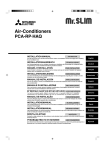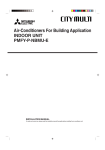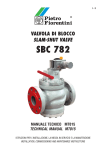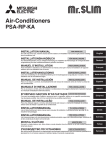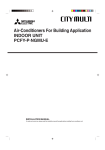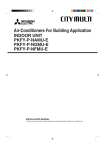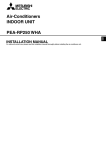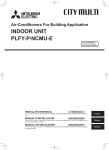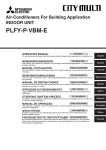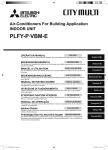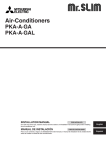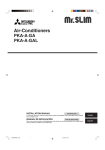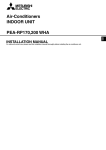Download Mitsubishi Electric PLFY-P.NAMU-E Installation manual
Transcript
Air-Conditioners For Building Application INDOOR UNIT PLFY-P·NAMU-E INSTALLATION MANUAL For safe and correct use, please read this installation manual thoroughly before installing the air-conditioner unit. Contents 1. 2. 3. 4. Safety precautions ................................................................................... Installation location .................................................................................. Installing the indoor unit ........................................................................... Installing the refrigerant piping ................................................................. 2 3 3 5 5. 6. 7. 8. Drainage piping work ............................................................................... 6 Electrical work .......................................................................................... 7 Test run .................................................................................................... 9 Installing the grille .................................................................................. 10 1. Safety precautions s Before installing the unit, make sure you read all the “Safety precautions”. s Please report to your supply authority or obtain their consent before connecting this equipment to the power supply system. Warning: Describes precautions that must be observed to prevent danger of injury or death to the user. Caution: Describes precautions that must be observed to prevent damage to the unit. Warning: • Ask a dealer or an authorized technician to install the unit. • For installation work, follow the instructions in the Installation Manual and use tools and pipe components specifically made for use with refrigerant specified in the outdoor unit installation manual. • The unit must be installed according to the instructions in order to minimize the risk of damage from earthquakes, typhoons, or strong winds. An incorrectly installed unit may fall down and cause damage or injuries. • The unit must be securely installed on a structure that can sustain its weight. • If the air conditioner is installed in a small room, measures must be taken to prevent the refrigerant concentration in the room from exceeding the safety limit in the event of refrigerant leakage. Should the refrigerant leak and cause the concentration limit to be exceeded, hazards due to lack of oxygen in the room may result. After installation work has been completed, explain the “Safety Precautions,” use, and maintenance of the unit to the customer according to the information in the Operation Manual and perform the test run to ensure normal operation. Both the Installation Manual and Operation Manual must be given to the user for keeping. These manuals must be passed on to subsequent users. : Indicates a part which must be grounded. Warning: Carefully read the labels affixed to the main unit. • Ventilate the room if refrigerant leaks during operation. If refrigerant comes into contact with a flame, poisonous gases will be released. • All electric work must be performed by a qualified technician according to local regulations and the instructions given in this manual. • Use only specified cables for wiring. • The terminal block cover panel of the unit must be firmly attached. • Use only accessories authorized by Mitsubishi Electric and ask a dealer or an authorized technician to install them. • The user should never attempt to repair the unit or transfer it to another location. • After installation has been completed, check for refrigerant leaks. If refrigerant leaks into the room and comes into contact with the flame of a heater or portable cooking range, poisonous gases will be released. 1.1. Before installation (Euvironment) Caution: • Do not use the unit in an unusual environment. If the air conditioner is installed in areas exposed to steam, volatile oil (including machine oil), or sulfuric gas, areas exposed to high salt content such as the seaside, the performance can be significantly reduced and the internal parts can be damaged. • Do not install the unit where combustible gases may leak, be produced, flow, or accumulate. If combustible gas accumulates around the unit, fire or explosion may result. • Do not keep food, plants, caged pets, artwork, or precision instruments in the direct airflow of the indoor unit or too close to the unit, as these items can be damaged by temperature changes or dripping water. • When the room humidity exceeds 80% or when the drainpipe is clogged, water may drip from the indoor unit. Do not install the indoor unit where such dripping can cause damage. • When installing the unit in a hospital or communications office, be prepared for noise and electronic interference. Inverters, home appliances, high-frequency medical equipment, and radio communications equipment can cause the air conditioner to malfunction or breakdown. The air conditioner may also affect medical equipment, disturbing medical care, and communications equipment, harming the screen display quality. 1.2. Before installation or relocation Caution: • Be extremely careful when transporting the units. Two or more persons are needed to handle the unit, as it weighs 44 lbs. (20 kg) or more. Do not grasp the packaging bands. Wear protective gloves as you can injure your hands on the fins or other parts. • Be sure to safely dispose of the packaging materials. Packaging materials, such as nails and other metal or wooden parts may cause stabs or other injuries. • Thermal insulation of the refrigerant pipe is necessary to prevent condensation. If the refrigerant pipe is not properly insulated, condensation will be formed. • Place thermal insulation on the pipes to prevent condensation. If the drainpipe is installed incorrectly, water leakage and damage to the ceiling, floor, furniture, or other possessions may result. • Do not clean the air conditioner unit with water. Electric shock may result. • Tighten all flare nuts to specification using a torque wrench. If tightened too much, the flare nut can break after an extended period. 1.3. Before electric work Caution: • Be sure to install circuit breakers. If not installed, electric shock may result. • For the power lines, use standard cables of sufficient capacity. Otherwise, a short circuit, overheating, or fire may result. • When installing the power lines, do not apply tension to the cables. • Be sure to ground the unit. If the unit is not properly grounded, electric shock may result. • Use circuit breakers (ground fault interrupter, isolating switch (+B fuse), and molded case circuit breaker) with the specified capacity. If the circuit breaker capacity is larger than the specified capacity, breakdown or fire may result. 1.4. Before starting the test run Caution: • Turn on the main power switch more than 12 hours before starting operation. Starting operation just after turning on the power switch can severely damage the internal parts. • Before starting operation, check that all panels, guards and other protective parts are correctly installed. Rotating, hot, or high voltage parts can cause injuries. 2 • Do not operate the air conditioner without the air filter set in place. If the air filter is not installed, dust may accumulate and breakdown may result. • Do not touch any switch with wet hands. Electric shock may result. • Do not touch the refrigerant pipes with bare hands during operation. • After stopping operation, be sure to wait at least five minutes before turning off the main power switch. Otherwise, water leakage or breakdown may result. 2. Installation location Refer to the outdoor unit installation manual. 3. Installing the indoor unit 1 3.1. Check the indoor unit accessories (Fig. 3-1) 2 3 The indoor unit should be supplied with the following accessories. 5 6 7 Accessory name Installation template Washers (with insulation) Washers (without insulation) Pipe cover (for refrigerant piping joint) Small diameter Large diameter Band (large) Band (small) Screw with washer (M5 × 25) for mounting grille Drain socket Insulation 8 Flare nut 1 2 4 3 4 5 6 P18 P36 7 Q’ty 1 4 4 1 1 6 2 4 1 1 2 <ø3/8"(9.52), ø5/8" (15.88)> 1 <ø3/4" (19.05)> 8 Fig. 3-1 3.2. Ceiling openings and suspension bolt installation locations (Fig. 3-2) 37-3/8 (950) D 25/32 (20) to 1-25/32 (45) 33-27/32 (860) to 35-13/16 (910) C 25/32 (20) to 1-25/32 (45) • Using the installation template (top of the package) and the gauge (supplied as an accessory with the grille), make an opening in the ceiling so that the main unit can be installed as shown in the diagram. (The method for using the template and the gauge are shown.) * Before using, check the dimensions of template and gauge, because they change due to fluctuations of temperature and humidity. * The dimensions of ceiling opening can be regulated within the range shown in following diagram; so center the main unit against the opening of ceiling, ensuring that the respective opposite sides on all sides of the clearance between them becomes identical. • Use M10 (3/8") suspension bolts. * Suspension bolts are to be procured at the field. • Install securely, ensuring that there is no clearance between the ceiling panel & grille, and between the main unit & grille. 23-13/16 (605) B 6-1/4 (159) 7-3/4 (197) 33-27/32 (860) to 35-13/16 (910) C 6-1/4 (159) 7-9/16 (192) 3-27/32 (98) 37-3/8 (950) D 33-1/16 (840) A 31-7/8 (810) B 6-1/4 (159) 6-1/4 (159) 11/16 +3/16 (17 +50 ) 0 F E C ∗D ∗1-15/16 (50) to 2-3/4 (70) ∗4-1/8 (105) F 1-3/16 (30) E Min. 40 (1000) G 11/16 +3/16 (17 +5 0) 0 5-5/16 (135) 33-1/16 (840) A Min. 20 (500) H 1(26) B A 7-9/16(98) G A 2-3/8 (60) 11-1/4 (286) F 14-23/32 Outer side of main unit Bolt pitch Ceiling opening Outer side of Grille Grille Ceiling Multi function casement (option) Entire periphery Note that the space between ceiling panel of the unit and ceiling slab and etc must be 3/8 in. (10 mm) to 9/16 in. (15 mm). in. (mm) Models P12, P15, P18, P24 P30, P36 Fig. 3-2 ED A B C D E F G H * A (374) A B C D E F G Drain pipe Ceiling Grille Refrigerant pipe (liquid) Refrigerant pipe (gas) Water supply inlet Main unit C 9-1/2 (241) 11-1/16 (281) D 10-3/16 (258) 11-3/4 (298) 3.3. Refrigerant and drainage piping locations of indoor unit The figure marked with * in the drawing represent the dimensions of the main unit excluding those of the optional multi function casement. (Fig. 3-3) • When the optional multi-functional casement is installed, add 5-5/16 in. (135 mm) to the dimensions marked on the figure. ∗6-11/16 (170) ∗5-1/2 (140) ∗7-15/32 (190) in. (mm) B C Models P12, P15 P18, P24, P30 P36 A 3 (76) 3-5/32 (80) 3-5/16 (84) B 3-11/32 (85) 3-1/2 (89) 3-1/2 (89) Fig. 3-3 3 3. Installing the indoor unit in. (mm) C At the time of installation, use the duct holes (cut out) located at the positions shown in following diagram, as and when required. • A fresh air intake hole for the optional multi function casement can also be made. Note: The figure marked with * in the drawing represent the dimensions of the main unit excluding those of the optional multi function casement. When installing the optional multi function casement, add 5-5/16 in. (135 mm) to the dimensions marked on the figure. When installing the branch ducts, be sure to insulate adequately. Otherwise condensation and dripping may occur. K L M 120° B 120° A ∗6-7/32 (158) A N O E 3-17/32 3-15/16 3-15/16 3-17/32 (90) (100) (100) (90) G J ∗6-3/32(155) ∗6-9/16(167) 70° F 3-15/16(100) 5-1/8(130) D H 13-25/32(350) 3.4. Branch duct hole and fresh air intake hole (Fig. 3-4) I A B C D E F Branch duct hole Indoor unit Fresh air intake hole Drain pipe Refrigerant pipe Branch duct hole diagram (view from either side) G Cut out hole H 14-ø1/8" (ø2.8) burring hole I J K L M N O ø5-29/32" (ø150) cut out hole ø6-7/8" (ø175) burring hole pitch Fresh air intake hole diagram 3-ø1/8" (ø2.8) burring hole ø4-29/32" (ø125) burring hole pitch ø3-15/16" (ø100) cut out hole Ceiling Fig. 3-4 in. (mm) A Unit B Grille C Pillar A C B Max. 6in.(15cm) 1 D E J F 10) 4 (8 57/6 31- D E F G 2 2313 (60 /16 5) F G H Use inserts rated at 250-350 lbs each (procure locally) I Suspension bolts 3/8" (M10) (procure locally) J Steel reinforcing rod Ceiling Rafter Beam Roof beam Fig. 3-5 A A B C D E F G B A C D Suspension bolt Ceiling Nut Washer (with insulation) Mounting plate Washer (without insulation) Check using the Installation gauge A=17 +50 B 4-1/8(105 ) 11/16+3/16 0 +5 (17 0 ) G Min. 1-3/16 (30) F C C A B C D B Fig. 3-6 D Main unit Ceiling Gauge Ceiling opening dimensions Fig. 3-7 A B C D Fig. 3-8 4 • The ceiling work differs according to the construction of the building. Building constructors and interior decorators should be consulted for details. (1) Extent of ceiling removal: The ceiling must be kept completely horizontal and the ceiling foundation (framework: wooden slats and slat holders) must be reinforced in order to protect the ceiling from vibration. (2) Cut and remove the ceiling foundation. (3) Reinforce the ends of the ceiling foundation where it has been cut and add ceiling foundation for securing the ends of the ceiling board. (4) When installing the indoor unit on a slanting ceiling, attach a pillar between the ceiling and the grille and set so that the unit is installed horizontally. 1 Wooden structures • Use tie beams (single storied houses) or second floor beams (two story houses) as reinforcing members. • Wooden beams for suspending air conditioners must be sturdy and their sides must be at least 2-3/8 in. (6 cm) long if the beams are separated by not more than 35-7/16 in. (90 cm) and their sides must be at least 3-9/16 in. (9 cm) long if the beams are separated by as much as 70-7/18 in. (180 cm). The size of the suspension bolts should be ø3/8 in. (ø10). (The bolts do not come with the unit.) 2 Ferro-concrete structures Secure the suspension bolts using the method shown, or use steel or wooden hangers, etc. to install the suspension bolts. A E 3.5. Suspension structure (Give site of suspension strong structure) (Fig. 3-5) A Main unit B Ceiling C Installation template (top of the package) D Screw with washer (Accessory) 3.6. Unit suspension procedures (Fig. 3-6) Suspend the main unit as shown in the diagram. Figures given in parentheses represent the dimensions in case of installing optional multi function casement. 1. In advance, set the parts onto the suspension bolts in the order of the washers (with insulation), washers (without insulation) and nuts (double). • Fit the washer with cushion so that the insulation faces downward. • In case of using upper washers to suspend the main unit, the lower washers (with insulation) and nuts (double) are to be set later. 2. Lift the unit to the proper height of the suspension bolts to insert the mounting plate between washers and then fasten it securely. 3. When the main unit can not be aligned against the mounting hole on the ceiling, it is adjustable owing to a slot provided on the mounting plate. +3/16 +5 • Make sure that step A is performed within 11/16 0 in. (17 0 mm). Damage could result by failing to adhere to this range. (Fig. 3-7) Caution: Use the top half of the box as a protective cover to prevent dust or debris from getting inside the unit prior to installation of the decorative cover or when applying ceiling materials. 3.7. Confirming the position of main unit and tightening the suspension bolts (Fig. 3-8) • Using the gauge attached to the grille, ensure that the bottom of the main unit is properly aligned with the opening of the ceiling. Be sure to confirm this, otherwise condensation may form and drip due to air leakage etc. • Confirm that the main unit is horizontally levelled, using a level or a vinyl tube filled with water. • After checking the position of the main unit, tighten the nuts of the suspension bolts securely to fasten the main unit. • The installation template (top of the package) can be used as a protective sheet to prevent dust from entering the main unit when the grilles are left unattached for a while or when the ceiling materials are to be lined after installation of the unit is finished. * As for the details of fitting, refer to the instructions given on the Installation template. 4. Installing the refrigerant piping 4.1. Precautions 4.1.1. For devices that use R22 refrigerant • Use the refrigeration oil applied to the flared sections. • Use C1220 copper phosphorus, for copper and copper alloy seamless pipes, to connect the refrigerant pipes. Use refrigerant pipes with the thicknesses specified in the table to the below. Make sure the insides of the pipes are clean and do not contain any harmful contaminants such as sulfuric compounds, oxidants, debris, or dust. 4.1.2. For devices that use R410A refrigerant • Use ester oil, ether oil, alkylbenzene oil (small amount) as the refrigeration oil applied to the flared sections. • Use C1220 copper phosphorus, for copper and copper alloy seamless pipes, to connect the refrigerant pipes. Use refrigerant pipes with the thicknesses specified in the table to the below. Make sure the insides of the pipes are clean and do not contain any harmful contaminants such as sulfuric compounds, oxidants, debris, or dust. Warning: When installing or moving the air conditioner, use only the specified refrigerant (R410A) to charge the refrigerant lines. Do not mix it with any other refrigerant and do not allow air to remain in the lines. Air enclosed in the lines can cause pressure peaks resulting in a rupture and other hazards. in. (mm) Liquid pipe Gas pipe P12, P15, P18 P24, P30, P36 1/4" (ø6.35) thickness 1/32" (0.8) 3/8" (ø9.52) thickness 1/32" (0.8) 1/2" (ø12.7) thickness 1/32" (0.8) 5/8" (ø15.88) thickness 3/64" (1.0) • Do not use pipes thinner than those specified above. A 4.2. Connecting pipes (Fig. 4-1) B 45°±2° øA /6 R1 90° ±0.5° C 2 1/3 oR 4t D Fig. 4-1 • When commercially available copper pipes are used, wrap liquid and gas pipes with commercially available insulation materials (heat-resistant to 212 °F (100 °C) or more, thickness of 1/2 in. (12 mm) or more). • The indoor parts of the drain pipe should be wrapped with polyethylene foam insulation materials (specific gravity of 0.03, thickness of 23/64 in. (9 mm) or more). • Apply thin layer of refrigerant oil to pipe and joint seating surface before tightening flare nut. • Use two wrenches to tighten piping connections. • Use refrigerant piping insulation provided to insulate indoor unit connections. Insulate carefully. B Flare nut tightening torque A Flare cutting dimensions Copper pipe O.D. 1/4" (ø6.35) 3/8" (ø9.52) 1/2" (ø12.7) 5/8" (ø15.88) 3/4" (ø19.05) Copper pipe O.D. in. (mm) 1/4" (ø6.35) 1/4" (ø6.35) 3/8" (ø9.52) 1/2" (ø12.7) 1/2" (ø12.7) 5/8" (ø15.88) 5/8" (ø15.88) 3/4" (ø19.05) in. (mm) Flare dimensions øA dimensions 11/32-23/64 (8.7 - 9.1) 1/2-33/64 (12.8 - 13.2) 41/64-21/32 (16.2 - 16.6) 49/64-25/32 (19.3 - 19.7) 15/16-61/64 (23.6 - 24.0) A Available pipe size A B in. (mm) A Copper pipe O.D. 1/4" (ø6.35) 3/8" (ø9.52) 1/2" (ø12.7) 5/8" (ø15.88) 3/4" (ø19.05) Tightening torque ft·lbs. (N·m) 10-13 (14 - 18) 25-30 (34 - 42) 25-30 (34 - 42) 35-44 (49 - 61) 49-59 (68 - 82) 49-59 (68 - 82) 72-87 (100 - 120) 72-87 (100 - 120) C Apply refrigerating machine oil over the entire flare seat surface. D Use correct flare nuts meeting the pipe size of the outdoor unit. A Die B Copper pipe Fig. 4-2 Flare nut O.D. in. (mm) 43/64 (17) 7/8 (22) 7/8 (22) 1-3/64 (26) 1-9/64 (29) 1-9/64 (29) 1-27/64 (36) 1-27/64 (36) P12, P15 P18 P24, P30 1/4" (ø6.35) 1/4" (ø6.35) – Liquid side – 3/8" (ø9.52) 3/8" (ø9.52) 1/2" (ø12.7) 1/2" (ø12.7) – Gas side – 5/8" (ø15.88) 5/8" (ø15.88) – – – : Factory flare nut attachment to the heat-exchanger. in. (mm) P36 – 3/8" (ø9.52) – 5/8" (ø15.88) 3/4" (ø19.05) Flare tool for R22 Flare tool for R410A Clutch type 0-1/64 (0 - 0.5) 3/64-1/16 (1.0 - 1.5) 0-1/64 (0 - 0.5) 3/64-1/16 (1.0 - 1.5) 0-1/64 (0 - 0.5) 3/64-1/16 (1.0 - 1.5) 0-1/64 (0 - 0.5) 3/64-1/16 (1.0 - 1.5) 0-1/64 (0 - 0.5) 3/64-1/16 (1.0 - 1.5) 5 4. Installing the refrigerant piping A Refrigerant pipe and insulating material B Pipe cover (large) C Pipe cover (small) D Refrigerant pipe (gas) E Refrigerant pipe (liquid) F Band G Cross-sectional view of connection H Pipe I Insulating material A J Squeeze G D B F E C F 4.3. Indoor unit (Fig. 4-3) Heat insulation for refrigerant pipes: 1 Wrap the enclosed large-sized pipe cover around the gas pipe, making sure that the end of the pipe cover touches the side of the unit. 2 Wrap the enclosed small-sized pipe cover around the liquid pipe, making sure that the end of the pipe cover touches the side of the unit. 3 Secure both ends of each pipe cover with the enclosed bands. (Attach the bands 13/16 in. (20 mm) from the ends of the pipe cover.) • After connecting the refrigerant piping to the indoor unit, be sure to test the pipe connections for gas leakage with nitrogen gas. (Check that there is no refrigerant leakage from the refrigerant piping to the indoor unit.) 4.4. For twin/triple combination Refer to the outdoor unit installation manual. B,C J I H Fig. 4-3 5. Drainage piping work 5.1. Drainage piping work (Fig. 5-1) Max. 65ft. (20m) • Use VP25 (1-1/4 in. (ø32) O.D. PVC TUBE) for drain piping and provide 1/100 or more downward slope. • Be sure to connect the piping joints using a polyvinyl type adhesive. • Observe the figure for piping work. • Use the included drain hose to change the extraction direction. 5 to 7ft. (1.5-2m) C Max. 6in.(15cm) A B J F K 1 2 A B Correct piping Wrong piping Insulation (3/8 in. (9 mm) or more) Downward slope (1/100 or more) C K L M Support metal Air bleeder Raised Odor trap Grouped piping D E F G H L B 1-1/4 in. (ø32) PVC TUBE Make it as large as possible Indoor unit Make the piping size large for grouped piping. Downward slope (1/100 or more) I 1-1/4 in. (ø38) PVC TUBE for grouped piping. (3/8 in. (9 mm) or more insulation) J Up to 33-7/16 (85 mm) M D E D D F F F G H I Fig. 5-1 in. (mm) A B C K F G C J 7/16(11) 1(25) 1(25) 1(25) D E H I E C Fig. 5-2 6 1. Connect the drain socket (supplied with the unit) to the drain port. (Fig. 5-2) (Affix the tube using PVC adhesive then secure it with a band.) 2. Install a locally purchased drain pipe (PVC pipe, 1-1/4 in. (ø32 mm) O.D.). (Affix the pipe using PVC adhesive then secure it with a band.) 3. Insulate the tube and pipe. (PVC pipe, 1-1/4 in. (ø32 mm) O.D. and socket) 4. Check that drain flows smoothly. 5. Insulate the drain port with insulating material, then secure the material with a band. (Both insulating material and band are supplied with the unit.) A B C D E F Unit Insulating material Band Drain port (transparent) Insertion margin Matching G H I J Drain pipe (1-1/4 in. (ø32) O.D. PVC TUBE) Insulating material (purchased locally) Transparent PVC pipe 1-1/4 in. (ø32) O.D. PVC TUBE (Slope 1/ 100 or more) K Drain socket 6. Electrical work A B C D E A Switch 15 A Overcurrent protection 15 A Indoor unit Total operating current be less than 15 A Ground B D C C C C C C C E Fig. 6-1 1 B M1 M2 A M1 M2 S 1 2 TB5 M1 M2 S TB15 E C C Fig. 6-2 B 2 M1 M2 TB3 A A M1 M2 S M1 M2 S TB5 [Selecting non-fuse breaker (NF) or earth leakage breaker (NV)] To select NF or NV instead of a combination of Class B fuse with switch, use the following: • In the case of Class B fuse rated 15 A or 20 A, NF model name (MITSUBISHI): NF30-CS (15 A) (20 A) NV model name (MITSUBISHI): NV30-CA (15 A) (20 A) Use an earth leakage breaker with a sensitivity of less than 30 mA 0.1 sec. 6.2. Connecting remote controller, indoor and outdoor transmission cables 1 2 TB15 TB5 D Power cable size (diameter) : more than 1.6 mm (AWG14) Ground cable size (diameter) : 1.6 mm (AWG14) * Use copper supply wires. * Use the electric wires over the rating voltage 300 V. Caution: Do not use anything other than the correct capacity breaker and fuse. Using fuse, wire or copper wire with too large capacity may cause a risk of malfunction or fire. A TB3 6.1. Power supply wiring (Fig. 6-1) • Connect indoor unit TB5 and outdoor unit TB3. (Non-polarized 2-wire) The “S” on indoor unit TB5 is a shielding wire connection. For specifications about the connecting cables, refer to the outdoor unit installation manual. • Install a remote controller following the manual supplied with the remote controller. • Connect the remote controller’s transmission cable within 33 ft (10 m) using a 0.75 mm2 (AWG18) core cable. If the distance is more than 33 ft (10 m), use a 1.25 mm2 junction cable. 1 MA Remote controller (Fig. 6-2) • Connect the “1” and “2” on indoor unit TB15 to a MA remote controller. (Non-polarized 2-wire) • DC 9 to 13 V between 1 and 2 (MA remote controller) 2 M-NET Remote controller (Fig. 6-3) • Connect the “M1” and “M2” on indoor unit TB5 to a M-NET remote controller. (Nonpolarized 2-wire) • DC 24 to 30 V between M1 and M2 (M-NET remote controller) A Terminal block for indoor transmission cable B Terminal block for outdoor transmission cable C Remote controller TB5 D Transmission cables E Remote control cables Constraints on transmission cable D Longest wiring length (L1+L2+L4 or L1+L3 or L2+L3+L4): less than 656 ft (200 m) Length between indoor unit and remote controller (R): within 33 ft (10 m) C C Fig. 6-3 G *1 G H I J K L E Outdoor unit Earth BC controller Indoor unit M-NET Remote controller Non-polarized 2-wire Note: *1 Put the transmission cable earth via the outdoor unit’s earth terminal to the ground. *2 If the remote controller cable exceeds 33 ft (10 m), use a 1.25 mm2 (AWG16) diameter cable over the exceeded portion, and add that exceeded portion to within 656 ft (200 m). *3 The BC controller is required only for simultaneous cooling and heating series R2. Types of control cables (Fig. 6-4) H I 1. Wiring transmission cables: Shielding wire CVVS or CPEVS • Cable diameter: More than 1.25 mm2 (AWG16) *3 J J 2. M-NET Remote control cables J Kind of remote control cable L1 L2 K J L K J Fig. 6-4 K More than 0.5 (AWG20) to 0.75 mm2 (AWG18) Remarks When 10 m is exceeded, use cable with the same specifications as transmission line wiring (shielding portion is more than 1.25 mm 2 (AWG16)) *2 r 3. MA Remote control cables L3 K L4 2-core cable (unshielded) Cable diameter K Kind of remote control cable Cable diameter 2-core cable (unshielded) 0.3 mm2 (AWG22) to 1.25 mm2 (AWG16) 7 6. Electrical work F B E A B G D C A H,I Fig. 6-5 6.3. Wiring connection (Fig. 6-5) 1. Remove the holder and intake sensor. 2. Remove two service panels. 3. Wire the power cable and control cable separately through the respective wiring entries given in the diagram. • Do not allow slackening of the terminal screws • Always install earch. • Considering the case of suspending the electrical box during services, leave the wiring some allowance. (Approx. 2 to 4 in.) A Entry for control cable B Entry for power cable (Trade size of conduit: 1/2") C Service panel for indoor controller switch setting D Service panel for electrical wiring E Terminal block for power supply F Terminal block for transmission line and M-NET remote controller G Terminal block for MA remote controller H Intake sensor I Holder s Fix power source wiring to control box using buffer bushing for tensile force. (PG connection or the like.) 6.4. Setting addresses (Fig. 6-6) (Be sure to operate with the main power turned OFF.) • There are two types of rotary switch setting available: setting addresses 1 to 9 and over 10, and setting branch numbers. 1 How to set addresses Example: If Address is “3”, remain SW12 (for over 10) at “0”, and match SW11(for 1 to 9) with “3”. 2 How to set branch numbers (Series R2 only) Match the indoor unit’s refrigerant pipe with the BC controller’s end connection number. Remain SW14 other than R2 at “0”. • The rotary switches are all set to “0” when shipped from the factory. These switches can be used to set unit addresses and branch numbers at will. • The determination of indoor unit addresses varies with the system at site. Set them referring to technical data. Note: Please set the switch SW5 according to the power supply voltage. • Set SW5 to 230 V side when the power supply is 230 volts. • When the power supply is 208 volts, set SW5 to 208 V side. 6.5. Switch setting for high ceiling or at the time of changing the number air outlets Address board SW5 220V (208V) SWA SWB 3 2 240V 3 (230V) 2 1 4 CN43 In this unit, the volume and speed of airflow can be adjusted by setting the switches (SWA and SWB) on the indoor controller board. ■ PLFY-P12/P15/P18/P24 SW1 ON OFF 1 2 3 4 5 6 7 8 9 10 SW12 SW11 0 0 2 SWC CN82 SW14 0 SWA 1 Standard 8.9 ft (2.7 m) 9.8 ft (3.0 m) 10.8 ft (3.3 m) 2 High ceiling 1 9.8 ft (3.0 m) 10.8 ft (3.3 m) 11.5 ft (3.5 m) 3 High ceiling 2 11.5 ft (3.5 m) 11.5 ft (3.5 m) – SWA 1 Standard 10.5 ft (3.2 m) 11.8 ft (3.6 m) 13.1 ft (4.0 m) 2 High ceiling 1 11.8 ft (3.6 m) 13.1 ft (4.0 m) 13.8 ft (4.2 m) 3 High ceiling 2 13.8 ft (4.2 m) 13.8 ft (4.2 m) – SWB 4 4 direction 3 3 direction 2 2 direction ■ PLFY-P30, P36 1 Fig. 6-6 SWB 4 4 direction 3 3 direction 2 2 direction SWA: Setting the ceiling height (set to standard at the factory) Set according to the ceiling height of the room where the unit will be installed. SWB: Setting the number of air outlets (set to 4 directions at the factory) Set according to the number of air outlets in the unit panel. SWC: Items sold separately (set to standard at the factory) Set to option when items sold separately, such as a high-efficiency filter element, are installed. 6.6. Sensing room temperature with the built-in sensor in a remote controller If you want to sense room temperature with the built-in sensor in a remote controller, set SW1-1 on the control board to “ON”. The setting of SW1-7 and SW1-8 as necessary also makes it possible to adjust the air flow at a time when the heating thermometer is OFF. 8 6. Electrical work B in. (mm) A 1-3/16 (30) 1) Installing procedures (1) Select an installing position for the remote controller. (Fig. 6-7) The temperature sensors are located on both remote controller and indoor unit. s Procure the following parts locally: Two piece switch box Thin copper conduit tube Lock nuts and bushings 1-3/16 (30) 1-37/64 (46) C A C D E F 4-23/32 (120) 3-9/32 (83.5) 1-3/16 (30) I G H Fig. 6-7 B-1. B-2. B H H I 6.7. Remote controller J I A Remote controller profile B Required clearances surrounding the remote controller C Installation pitch (2) Seal the service entrance for the remote controller cord with putty to prevent possible invasion of dew drops, water, cockroaches or worms. (Fig. 6-8) A For installation in the switch box: B For direct installation on the wall select one of the following: • Prepare a hole through the wall to pass the remote controller cord (in order to run the remote controller cord from the back), then seal the hole with putty. • Run the remote controller cord through the cut-out upper case, then seal the cutout notch with putty similarly as above. B-1. To lead the remote controller cord from the back of the controller: B-2. To run the remote controller cord through the upper portion: (3) For direct installation on the wall C D E F G H I J Fig. 6-8 Wall Conduit Lock nut Bushing Switch box Remote controller cord Seal with putty Wood screw 2) Connecting procedures (Fig. 6-9) 1 Connect the remote controller cord to the terminal block. A A To TB5 on the indoor unit B TB6 (No polarity) AB Fig. 6-9 TB6 B 3) Temperature display setting The initial temperature display setting is °C. Please change the setting to °F. Refer to “Function selection of remote controller (Section 8)” in the operation manual for the indoor unit. 4) Two remote controllers setting If two remote controllers are connected, set one to “Main” and the other to “Sub”. For setting procedures, refer to “Function selection of remote controller” in the operation manual for the indoor unit. 7. Test run 7.1. Before test run s After completing installation and the wiring and piping of the indoor and outdoor units, check for refrigerant leakage, looseness in the power supply or control wiring, wrong polarity, and no disconnection of one phase in the supply. s Use a 500-volt megohmmeter to check that the resistance between the power supply terminals and ground is at least 1.0 MΩ. F E C D B TEST RUN COOL, HEAT ˚F ˚F SIMPLE TEMP. MENU BACK MONITOR/SET PAR-21MAA HG ON/OFF ON/OFF CLOCK A FILTER DAY CHECK TEST OPERATION CLEAR I M Fig. 7-1 A ON/OFF button B Test run display C Indoor temperature liquid line temperature display D ON/OFF lamp E Power display F Error code display Test run remaining time display G Set temperature button H Mode selection button I Fan speed button M TEST button s Do not carry out this test on the control wiring (low voltage circuit) terminals. Warning: Do not use the air conditioner if the insulation resistance is less than 1.0 MΩ. Insulation resistance 7.2. Test run (Fig. 7-1) The following 3 methods are available. 1 Turn on the power at least 12 hours before the test run. 2 Press the [TEST] button twice. ➡ “TEST RUN” liquid crystal display 3 Press the [Mode selection] button. ➡ Make sure that wind is blown out. 4 Press the [Mode selection] button and switch to the cooling (or heating) mode. ➡ Make sure that cold (or warm) wind is blown out. 5 Press the [Fan speed] button. ➡ Make sure that the wind speed is switched. 6 Check operation of the outdoor unit fan. 7 Release test run by pressing the [ON/OFF] button. ➡ Stop 8 Register a telephone number. The telephone number of the repair shop, sales office, etc., to contact if an error occurs can be registered in the remote controller. The telephone number will be displayed when an error occurs. For registration procedures, refer to the operation manual for the indoor unit. Note: • If an error code is displayed on the remote controller or if the air conditioner does not operate properly, refer to the outdoor unit installation manual or other technical materials. • The OFF timer is set for the test run to automatically stop after 2 hours. • During the test run, the time remaining is shown in the time display. • During the test run, the temperature of the indoor unit refrigerant pipes is shown in the room temperature display of the remote controller. • When the VANE or LOUVER button is pressed, the message “NOT AVAILABLE” may appear on the remote controller display depending on the indoor unit model, but this is not a malfunction. 9 7. Test run 7.3. Check of drainage (Fig. 7-2) A B A B C D E C D E Insert the pump end 1-3/16 to 2 in. Cover of water supply inlet About 1/4 gal Water Drain plug Fig. 7-2 • During the test run, ensure the water is being properly drained out and that no water is leaking from joints. • Always check this during installation even if the unit is not required to provide cooling/drying at that time. • Similarly, check the drainage before finishing ceiling installation in a new premises. (1) Remove the cover of the water supply inlet and add about 1/4 gal (1000 cc) of water using a water supply pump etc. During this process, be careful not to spray water into the drain pump mechanism. (2) Confirm that water is being drained out through the drainage outlet, after switching over from remote control mode to test run mode. (3) After checking the drainage, ensure that the cover is replaced and the power supply is isolated. (4) After confirming the drainage system is functioning, replace the drain plug. 8. Installing the grille 8.1. Checking the contents (Fig. 8-1) 1 • This kit contains this manual and the following parts. 3 1 2 3 4 5 ø2 0 2 4 5 Accessory name Grille Screw with captive washer Gauge Fastener Screw Q’ty 1 4 1 2 4 Remark 37-3/8 (950) × 37-3/8 (950) M5 × 0.8 × 25 (Divided into four parts) 4×8 Fig. 8-1 8.2. Preparing to attach the grille (Fig. 8-2) A A=11/16+3/16 0 (17+50 ) • With the gauge 3 supplied with this kit, adjust and check the positioning of the unit relative to the ceiling. If the unit is not properly positioned relative to the ceiling, it may allow air leaks or cause condensation to collect. • Make sure that the opening in the ceiling is within the following tolerances: 33-7/8 × 33-7/8 to 35-13/16 × 35-13/16 in. (860 × 860 to 910 × 910 mm) • Make sure that step A is performed within 17-22 mm. Damage could result by failing to adhere to this range. B C D Fig. 8-2 A A B C D B 1 E Main unit Ceiling Gauge 3 (inserted into the unit) Ceiling opening dimensions 1 8.2.1. Removing the intake grille (Fig. 8-3) 2 C D Fig. 8-3 G B F F 1 • Slide the levers in the direction indicated by the arrow 1 to open the intake grille. • Unlatch the hook that secures the grille. * Do not unlatch the hook for the intake grille. • With the intake grille in the “open” position, remove the hinge of the intake grille from the grille as indicated by the arrow 2. 8.2.2. Removing the corner panel (Fig. 8-4) • Remove the screw from the corner of the corner panel. Slide the corner panel as indicated by the arrow 1 to remove the corner panel. A B C D Fig. 8-4 10 Intake grille Grille Intake grille levers Grille hook E Hole for the grille’s hook F Corner panel G Screw 8. Installing the grille 4-directional 8.3. Selection of the air outlets 3-directional One pattern: Factory setting 4 patterns: One air outlet fully closed Blowout direction patterns For this grille the discharge direction is available in 11 patterns. Also, by setting the Remote controller to the appropriate settings, you can adjust the air-flow and speed. Select the required settings from the Table according to the location in which you want to install the unit. 1) Decide on the discharge direction pattern. 2) Be sure to set the remote contoller to the appropriate settings, according to the number of air outlets and the height of the ceiling on which the unit will be installed. 2-directional Note: For 3 and 2-directional, please use the air outlet shutter plate (option). 6 patterns: Two air outlet fully closed Blowout direction patterns 19/32 to 25/32 (15 to 20) A 8.4. Installing the grille A Main unit B Screw with captive washer 8.4.1. Preparations (Fig. 8-5) • Install the two enclosed screws with washer 2 in the main unit (at the corner drain pipe area and at the opposite corner) as shown in the diagram. B Fig. 8-5 A C D G E F D B H I A C A Main unit B Detailed diagram of installed screw with washer 2. C Corner drain pipe area D Screw with washer 2 (for temporary use) E Grille F Screw with washer 2 G Hole A H Hole B I Bell shaped hole 8.4.2. Temporary installation of the grille (Fig. 8-6) • Temporarily secure the grille using the bell shaped holes by aligning the corner drain pipe area of the main unit with the two holes of the grille that are marked A and B. * Make sure that the lead wiring of the grille does not get pinched between the grille and the main unit. Fig. 8-6 8.4.3. Securing the grille (Fig. 8-7) E A B C D E Ceiling Main unit Grille Make sure that there are no gaps. Adjust the nut of the main unit using a wrench, etc. • Secure the grille to the main unit by tightening the previously installed two screws (with captive washer) as well as the two remaining screws (with captive washer). * Make sure that there are no gaps between the main unit and the grille or the grille and the ceiling. Fixing gaps between the grille and the ceiling With the grille attached, adjust the height of the main unit to close the gap. Fig. 8-7 A B C D E Clamp of the main unit Tube Connector of the main unit Grille connector Fastener 8.4.4. Wire connection (Fig. 8-8) • Be sure to connect the unit to the connector (white, 10-pole). Next, attach the white glass tube that comes with the main unit so that the tube covers the connector. Close the opening of the glass tube with the fastener. • Make sure that there is no slack in the lead wire at the clamp of the main unit. A E B Warning: If the connector is not covered with the glass tube, tracking resulting in fire may occur. C D Fig. 8-8 11 8. Installing the grille 8.5. Locking the up/down airflow direction (Fig. 8-9) A B The vanes of the unit can be set and locked in up or down orientations depending upon the environment of use. • Set according to the preference of the customer. The operation of the fixed up/down vanes and all automatic controls cannot be performed using the remote controller. In addition, the actual position of the vanes may differ from the position indicated on the remote controller. 1 Turn off the main power switch. Injuries and or an electrical shock may occur while the fan of the unit is rotating. 2 Disconnect the connector for the vane motor of the vent that you want to lock. (While pressing the button, remove the connector in the direction indicated by the arrow as shown in the diagram.) After removing the connector, insulate it with tape. C D A B C D B D Button Vane motor Up/down vanes Connector A Fig. 8-9 8.6. Check • Make sure that there is no gap between the unit and the grille, or between the grille and the surface of the ceiling. If there is any gap between the unit and the grille, or between the grille and the surface of the ceiling, it may cause dew to collect. • Make sure that the wires have been securely connected. G C 8.7. Installing the intake grille (Fig. 8-10) E D A B A Screw (4 × 8) 5 B Corner panel C Safety wire F Fig. 8-10 12 Note: When reinstalling the corner panels (each with a safety wire attached), connect the other end of each safety wire to the grille using a screw (4 pcs, 4 × 8) as shown in the illustration. * If the corner panels are not attached, they may fall off while the unit is operating. • Perform the procedure that is described in “8.2. Preparing to attach the grille” in reverse order to install the intake grille and the corner panel. • Multiple units can be installed with grille so that the position of the logo on each corner panel is consistent with the other units regardless of the orientation of the intake grille. Align the logo on the panel according to the wishes of the customer as shown in the diagram to the left. (The position of the grille can be changed.) D Refrigerant piping of the main unit E Drain piping of the main unit F Position of the corner panel when sent from the factory (logo attached). * Installation in any position is possible. G Position of the levers on the intake grille when sent from the factory. * Although the clips can be installed in any of four positions, the configuration shown here is recommended. (It is not necessary to remove the intake grille when maintenance is performed on the electric component box of the main unit.) This product is designed and intended for use in the residential, commercial and light-industrial environment. Please be sure to put the contact address/telephone number on this manual before handing it to the customer. HEAD OFFICE: MITSUBISHI DENKI BLDG., 2-2-3, MARUNOUCHI, CHIYODA-KU, TOKYO 100-8310, JAPAN BG79U666H01 Printed in Japan
















